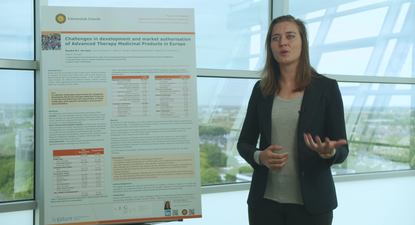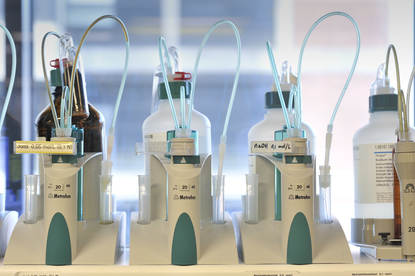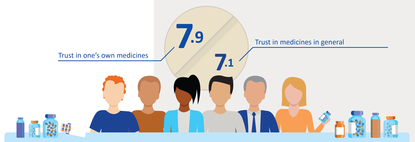Bloem, L.T., Mantel‐Teeuwisse, A.K., Leufkens, H.G., De Bruin, M.L., Klungel, O.H., & Hoekman, J. (2019). Postauthorization Changes to Specific Obligations of Conditionally Authorized Medicines in the European Union: A Retrospective Cohort Study. Clinical Pharmacology & Therapeutics, 105(2), 426-435.
This study shows that regulatory learning about benefits and risks of conditionally approved medicines is facilitated i) by prospective planning of post-approval obligations (mostly studies) and ii) when additional attention is paid to obligations addressing a high level of uncertainty.
De Vries, S.T., Denig, P., Ekhart, C., Burgers, J.S., Kleefstra, N., Mol, P.G.M., & Van Puijenbroek, E.P. (2019). Sex differences in adverse drug reactions reported to the national pharmacovigilance centre in the Netherlands An explorative observational study. British journal of clinical pharmacology.
Koziolek, M., Alcaro, S., Augustijns, P., Basit, A.W., Grimm, M., Hens, B., Marciani, L. et al. (2019). The mechanisms of pharmacokinetic food-drug interactions – A perspective from the UNGAP group. European Journal of Pharmaceutical Sciences, 134, 31-59.
Krause, S., Lacana, E., Welch, J.W., Shapiro, M., Downey, C., Chung, J. & Srebalus-Barnes, C. (2019). PDA Biosimilars Workshop Report (27-28Sep18) – Getting It Right the First Time for Biosimilar Marketing Applications. PDA journal of pharmaceutical science and technology.
Lenić, I., Blake, K., García Arieta, A., Potthast, H., & Welink, J. (2019). Overview of the European Medicines Agency's experience with biowaivers in centralised applications. Clinical and translational science.
Minnema, L.A., Giezen, T.J., Gardarsdottir, H., Egberts, T.C., Leufkens, H.G., & Mantel‐Teeuwisse, A.K. (2019). Post‐marketing dosing changes in the label of biologicals. British journal of clinical pharmacology, 85(4), 715-721.
This study showed that in 11% of the biologicals, the dosing for the initial indication in the label was changed. In contrast to small molecules, the dose was rarely reduced for safety reasons
Minnema, L.A., Giezen, T.J., Souverein, P.C., Egberts, T.C., Leufkens, H.G., & Gardarsdottir, H. (2019). Exploring the Association between Monoclonal Antibodies and Depression and Suicidal Ideation and Behavior: A VigiBase Study. Drug safety, 1-9.
This study showed that depression and suicidal ideation and behavior are seen in patients using monoclonal antibodies, particularly monoclonal antibiodies used for treating autoimmune diseases that suppress the immune system.
Pierce, C.E., de Vries, S.T., Bodin-Parssinen, S., Härmark, L., Tregunno, P., Lewis, D.J., Dasgupta, N. et al. (2019). Recommendations on the Use of Mobile Applications for the Collection and Communication of Pharmaceutical Product Safety Information: Lessons from IMI WEB-RADR. Drug safety, 1-13.
Today we are used to having information available 24/7, and that it is possible to communicate about anything at any time that suits our busy lives. In the WEB-RADR (https://web-radr.eu/ ) project we evaluated the value of a mobile application (app) designed for adverse drug reaction (ADR) reporting and providing product safety alerts as an additional pharmacovigilance tool. This paper provides recommendations for development and implementation of apps that allow two-way risk communication (reporting and receiving safety info) between patients and health care professionals with relevant authorities.
Rossignol, P., Agarwal, R., Canaud, B., Charney, A., Chatellier, G., Craig, J.C., Guzman, N. et al. (2017). Cardiovascular outcome trials in patients with chronic kidney disease: challenges associated with selection of patients and endpoints. European heart journal, 40(11), 880-886.
Yu, Y., & Maliepaard, M. (2019). Interchangeability of Generics—Experiences and Outlook Toward Pharmacokinetics Variability and Generic‐Generic Substitution. Clinical Pharmacology & Therapeutics, 105(2), 292-294.
In this macroscopy paper, Regulatory Science knowledge towards generic-generic exchange, a topic creating some disturbance in clinical practice, is summarised. Based on our investigations, it is concluded that the potential for ‘drift’ in exposure upon such generic-generic switch in clinical practice is very limited. Further, it is demonstrated that variation in drug exposure following switching from branded to generic drug is comparable to that obtained by repeated administration of the branded or the generic drug. This is important to keep in mind when single drug plasma levels are determined following a switch to a generic.
Go to all publications of the MEB
IMI Roadmap Data Cube
On the May 6 2019, the IMI ROADMAP project released a Data Cube. Which offers an overview of the data availability in Europe for Alzheimer’s disease (AD) research. The name of the public-private ROADMAP project is an abbreviation for “The Real world Outcomes across the Alzheimer’s Disease spectrum for better care: Multi-modal data Access Platform”. The Data Cube allows the visualisation of different data sources and how they are able to capture different AD-outcomes and different disease stages. Users can switch between the perspectives of people with dementia, carers and healthcare professionals. With these efforts, ROADMAP aims to address the challenge of how best to inform clinical and health policy decisions. See the online version of the Data Cube.








